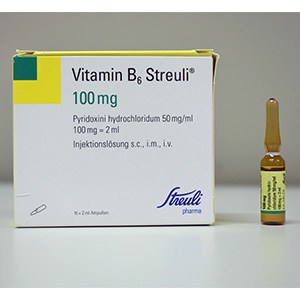Presentation
100mg/2mL ampoule
SAS
Role
Management of seizures following acute isoniazid poisoning.

Consultation with a clinical toxicologist is recommended through the local toxicology service or Poisons Information Centre 13 11 26.
Dose
- Dose should equal amount of isoniazid ingested (mg for mg) up to 5000mg (or 70mg/kg if child). If amount is unknown, give 5000mg (70mg/kg).1
- Give at a rate of 500mg/minute in 5% dextrose. If seizures are controlled before the full dose is given, administer the remaining pyridoxine as a slow IV infusion over 1-2 hours. Repeat dose after half an hour if seizures continue.1
Stocking recommendations
| Tertiary centre | Regional centre | Rural centre | Remote centre |
|---|---|---|---|
| 0-50 vials | 0 vials | 0 vials | 0 vials |
Rationale
Isoniazid poisoning is rare, and it is impractical to stock its antidote widely. There have been case reports of successful use of nasogastric administration of pyridoxine tablets in cases of overdose – which are readily available in most larger centres and therefore may be an appropriate alternative. Consult a clinical toxicologist for advice.
References
- Dilrukshi MDSA, Ratnayake CAP, Gnanathasan CA. Oral pyridoxine can substitute for intravenous pyridoxine in managing patients with severe poisoning with isoniazid and rifampicin fixed dose combination tablets: a case report. BMC Research Notes. 2017;10
Disclaimer
Fact sheet developed by Queensland Poisons Information Centre.
This fact sheet is about the use of these antidotes in Australia, and may not apply to other countries. Children’s Health Queensland Hospital and Health Service cannot be held responsible for the accuracy of information, omissions of information, or any actions that may be taken as a consequence of reading this fact sheet.